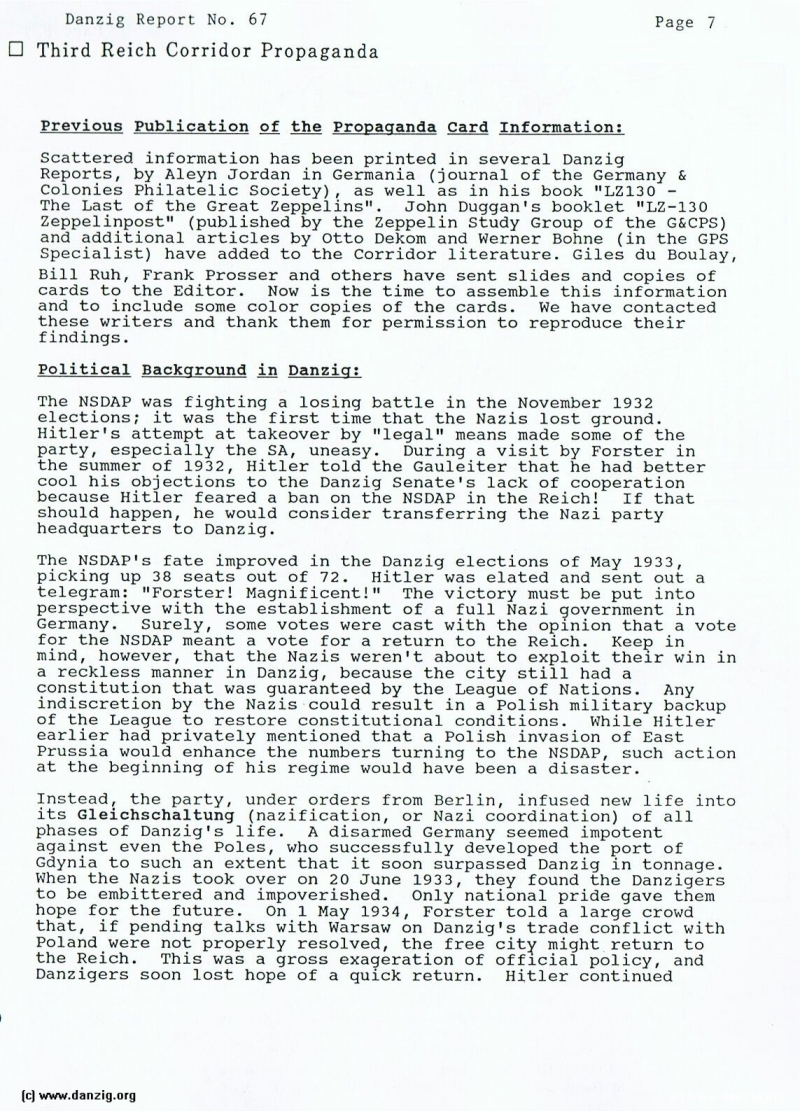
Third Reich Corridor Propaganda
Previous Publication of the Propaganda Card Information: Scattered information has been printed in several Danzig Reports, by Aleyn Jordan in Germania (journal of the Germany & Colonies Philatelic Society), as well as in his book “LZ13O - The Last of the Great Zeppelins”. John Duggan’s booklet “LZ—130 Zeppelinpost” (published by the Zeppelin Study Group of the G&CPS) and additional articles by Otto Dekom and Werner Bohne (in the GPS Specialist) have added to the Corridor literature. Giles du Boulay, Bill Ruh, Frank Prosser and others have sent slides and copies of cards to the Editor. Now is the time to assemble this information and to include some color copies of the cards. We have contacted these writers and thank them for permission to reproduce their findings.
Political Background in Danzig:
The NSDAP was fighting a losing battle in the November 1932 elections; it was the first time that the Nazis lost ground. Hitler’s attempt at takeover by “legal” means made some of the party, especially the SA, uneasy. During a visit by Forster in the summer of 1932, Hitler told the Gauleiter that he had better cool his objections to the Danzig Senate’s lack of cooperation because Hitler feared a ban on the NSDAP in the Reich! If that should happen, he would consider transferring the Nazi party headquarters to Danzig.
The NSDAP’s fate improved in the Danzig elections of May 1933, picking up 38 seats out of 72. Hitler was elated and sent out a telegram: “Forster! Magnificent!” The victory must be put into perspective with the establishment of a full Nazi overnment in Germany. Surely, some votes were cast with the opinion that a vote for the NSDAP meant a vote for a return to the Reich. Keep in mind, however, that the Nazis weren’t about to exploit their win in a reckless manner in Danzig, because the city still had a constitution that was guaranteed by the League of Nations. Any indiscretion by the Nazis could result in a Polish military backup of the League to restore constitutional conditions. While Hitler earlier had privately mentioned that a Polish invasion of East Prussia would enhance the numbers turning to the NSDAP, such action at the beginning of his regime would have been a disaster.
Instead, the party, under orders from Berlin, infused new life into its Gleichschaltung (nazification, or Nazi coordination) of all phases of Danzig’s life. A disarmed Germany seemed impotent against even the Poles, who successfully developed the port of Gdynia to such an extent that it soon surpassed Danzig in tonnage. When the Nazis took over on 20 June 1933, they found the Danzigers to be embittered and impoverished, Only national pride gave them hope for the future. On 1 May 1934, Forster told a large crowd that, if pending talks with Warsaw on Danzig’s trade conflict with Poland were not properly resolved, the free cit’ might return to the Reich. This was a gross exageration of official policy, and Danzigers soon lost hope of a quick return. Hitler continued
Danzig Report Vol. 1 - Nr. 67 - April - May - June - 1990, Page 7.
Hits: 4107
Added: 29/06/2015
Copyright: 2026 Danzig.org

